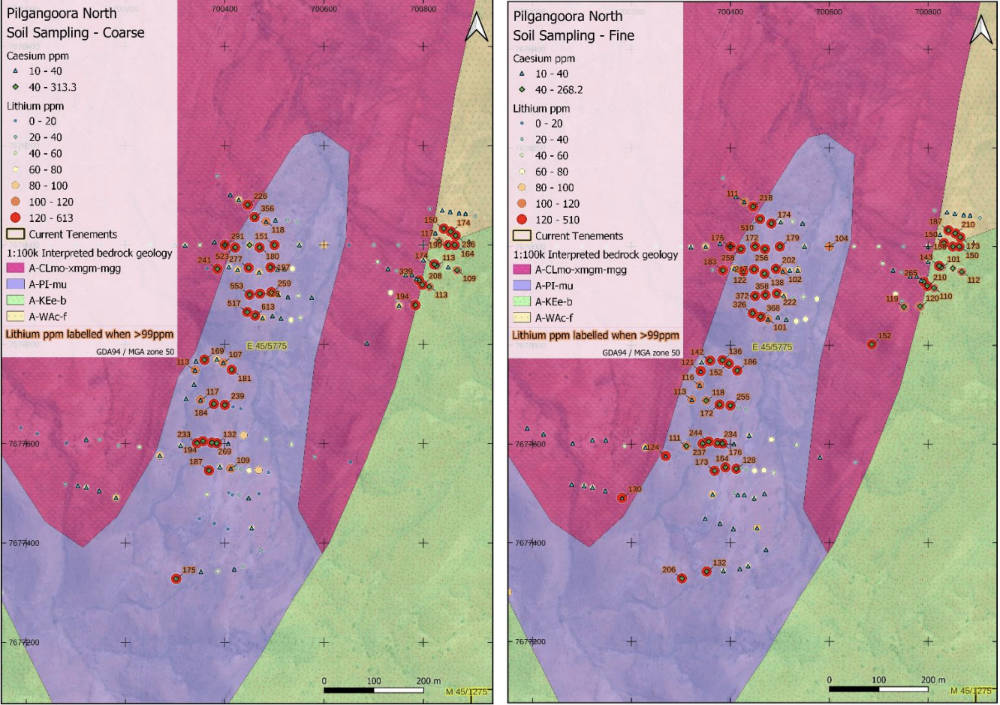In the Right Rocks: Soil sampling confirms lithium anomalism at Peregrine’s Pilgangoora North, 5km from Pilbara Minerals

Peregrine’s infill soil sampling has proved up the lithium-caesium anomaly at Pilgangoora North with up to 613ppm lithium and 313ppm caesium. Pic: via Getty Images.
- Peregrine’s recent infill soil sampling traces a coherent lithium-caesium anomaly at Pilgangoora North over 700m of strike
- Samples return up to 613ppm lithium and 313ppm caesium
- Additional infill and along strike soil sampling to begin shortly followed by detailed geological mapping in mid-November along with Heritage Clearances in advance of RC drilling
Peregrine’s infill soil sampling has returned up to 613ppm lithium and 313ppm caesium, proving without a doubt that an anomaly worthy of further exploration is present in the southern portion of its Pilgangoora North project which is just 5km along strike from the massive Pilbara Minerals 414Mt Pilgangoora lithium mine in WA’s Pilbara region.
Coincident lithium and caesium anomalism was noted near outcropping pegmatites within ultramafic host rock along two east to west sample lines, about 400 metres apart in the southern portion of the tenement.
This was an encouraging result for Peregrine Gold (ASX:PGD) as previous stream sediment and rock sampling had proven to be ineffective in localising areas hosting lithium-caesium-tantalum pegmatites despite the project having the right rocks for a big mineral discovery.
Pilgangoora North contains numerous lithium occurrences in addition to tin, tantalum, gold and lead while a sequence of ultramafic rocks mapped within the licence has the potential to host nickel and copper mineralisation.

Lithium-caesium anomaly now traced over 700m
The infill soil sampling program centred around the initial two east-west lines has returned up to 613ppm lithium and 313ppm caesium.
Peregrine collected 232 samples from 116 sites spread out over 13 lines between the two initial lines, resulting in the lithium-caesium anomaly being traced over a north-south strike of about 700m.
“The infill soil sampling programme was very effective in better defining the Li/Cs anomaly returning a maximum lithium response of 613 ppm Li along trend from the initial two soil lines,” technical director George Merhi said.
“With this confidence, additional infill and along strike soil sampling will commence shortly followed by detailed geological mapping in mid-November.
“Subject to heritage clearance, a reverse circulation drilling can commence.”
But don’t forget that 1952 g/t gold hit at Newman
Last week, assays from Peregrine Gold’s diamond drilling program at the Newman project in WA returned exceptionally high-grade gold results of up to a massive 1952 g/t.
The underexplored, district scale Newman gold project tenement package was assembled by Peregrine after noting that epizonal quartz textures were observed in the area by previous explorers as far back as the 1980’s.
Epizonal gold systems are known to produce the highest-grade gold deposits currently known, including the exceptional Swan zone at the Fosterville gold field.
Peregrine is still at the very early stages of exploring Newman, but it is confident the area will develop into Australia’s next great gold camp.
“The results from the diamond drilling program completed at the Newman gold project are highly significant and very encouraging,” technical director George Merhi said.
“The project area is located in a part of the Pilbara which has had limited or no historical gold exploration in the past other than a trenching programme over an epithermal occurrence by CRA Exploration in 1981.”
This article was developed in collaboration with Peregrine Gold, a Stockhead advertiser at the time of publishing.
This article does not constitute financial product advice. You should consider obtaining independent advice before making any financial decisions.
Related Topics

UNLOCK INSIGHTS
Discover the untold stories of emerging ASX stocks.
Daily news and expert analysis, it's free to subscribe.
By proceeding, you confirm you understand that we handle personal information in accordance with our Privacy Policy.








